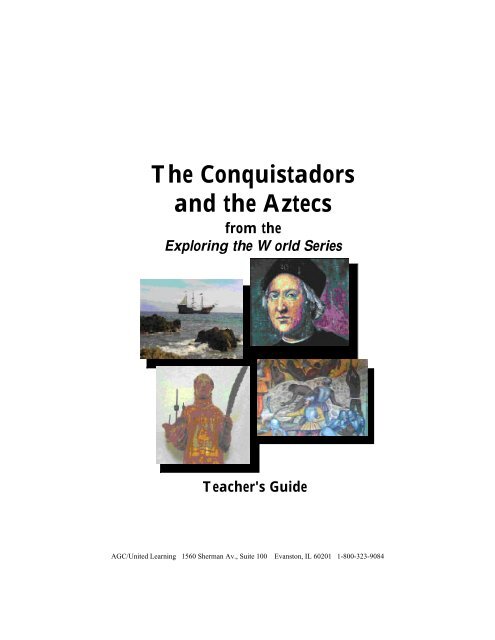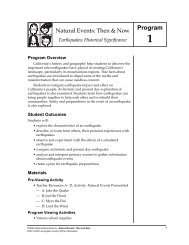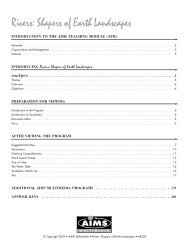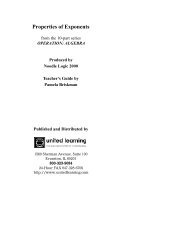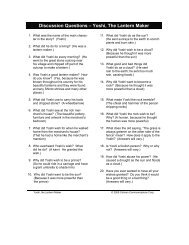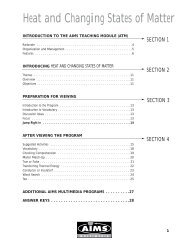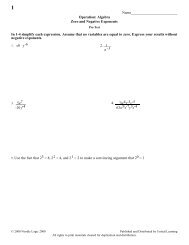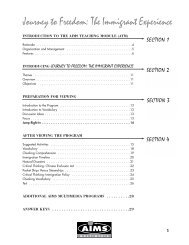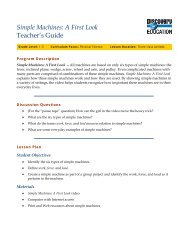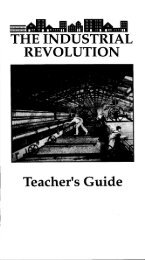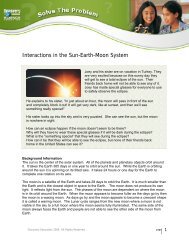The Conquistadors and the Aztecs - Discovery Education
The Conquistadors and the Aztecs - Discovery Education
The Conquistadors and the Aztecs - Discovery Education
Create successful ePaper yourself
Turn your PDF publications into a flip-book with our unique Google optimized e-Paper software.
<strong>The</strong> <strong>Conquistadors</strong><br />
<strong>and</strong> <strong>the</strong> <strong>Aztecs</strong><br />
from <strong>the</strong><br />
Exploring <strong>the</strong> World Series<br />
Teacher's Guide<br />
AGC/United Learning 1560 Sherman Av., Suite 100 Evanston, IL 60201 1-800-323-9084<br />
1
<strong>Conquistadors</strong> <strong>and</strong> <strong>the</strong> <strong>Aztecs</strong><br />
from <strong>the</strong><br />
Exploring <strong>the</strong> World Series<br />
catalog # 3397<br />
Published & Distributed by…<br />
AGC/UNITED LEARNING<br />
1560 Sherman Avenue<br />
Suite 100<br />
Evanston, IL 60201<br />
1-800-323-9084<br />
24-Hour Fax No. 847-328-6706<br />
Website: http://www.agcunitedlearning.com<br />
E-Mail: info@agcunited.com<br />
2<br />
AGC/United Learning 1560 Sherman Av., Suite 100 Evanston, IL 60201 1-800-323-9084
THE CONQUISTADORS AND THE AZTECS<br />
Grades 2-5<br />
Viewing Time: 12:00<br />
INTRODUCTION AND SUMMARY<br />
This program, photographed in Spain <strong>and</strong> Mexico, takes a<br />
look at how Spanish civilization was brought to North<br />
America. It begins with a look at <strong>the</strong> tremendous differences<br />
that existed between <strong>the</strong> Aztec <strong>and</strong> Spanish cultures 500<br />
years ago. Students find out how <strong>and</strong> why <strong>the</strong> Spanish<br />
came to <strong>the</strong> New World <strong>and</strong> learn some of <strong>the</strong> details of <strong>the</strong><br />
conquest of Mexico. Students also learn some of <strong>the</strong> longterm<br />
effects colonization by Europeans had on <strong>the</strong> people<br />
of <strong>the</strong> New World.<br />
CURRICULUM STANDARDS<br />
<strong>The</strong> design for this program was guided by <strong>the</strong> curriculum<br />
st<strong>and</strong>ards of <strong>the</strong> states of Texas, California, <strong>and</strong> Illinois, as<br />
well as <strong>the</strong> National Center for History in Schools (U.C.L.A).<br />
In accordance with <strong>the</strong>se guidelines, we have attempted to<br />
help students…<br />
• Describe <strong>the</strong> roles of important explorers <strong>and</strong> conquerers<br />
who sought new trade routes, economic gain, adventure,<br />
national glory, <strong>and</strong> <strong>the</strong> glory of God.<br />
• Identify <strong>the</strong> routes of <strong>the</strong> explorers <strong>and</strong> conquerors.<br />
• Describe how technological advantages, such as guns,<br />
cannons, metal armor, <strong>and</strong> <strong>the</strong> domestication of <strong>the</strong> horse,<br />
helped <strong>the</strong> European conquerors defeat <strong>the</strong> native tribes of<br />
<strong>the</strong> New World.<br />
• Describe what happened to <strong>the</strong> native peoples as a result<br />
of European colonization.<br />
AGC/United Learning 1560 Sherman Av., Suite 100 Evanston, IL 60201 1-800-323-9084<br />
3
• Develop improved concepts of time <strong>and</strong> chronology, as<br />
well as a vocabulary appropriate to <strong>the</strong>se subjects.<br />
INSTRUCTIONAL NOTES<br />
Before presenting this lesson to your students, we suggest<br />
that you review history textbooks on <strong>the</strong> subject of early<br />
European world exploration. We also advise you to preview<br />
<strong>the</strong> video <strong>and</strong> review this guide <strong>and</strong> accompanying<br />
blackline master activities in order to familiarize yourself<br />
with <strong>the</strong>ir content.<br />
As you review <strong>the</strong> materials presented in this guide, you<br />
may find it necessary to make some changes, additions, or<br />
deletions to meet <strong>the</strong> specific needs of your class. We<br />
encourage you to do so, for only by tailoring this program<br />
to your class will <strong>the</strong>y obtain <strong>the</strong> maximum instructional<br />
benefits afforded by <strong>the</strong> materials.<br />
It is also suggested that <strong>the</strong> video presentation take place<br />
before <strong>the</strong> entire group under your supervision. <strong>The</strong> lesson<br />
activities grow out of <strong>the</strong> context of <strong>the</strong> video; <strong>the</strong>refore,<br />
<strong>the</strong> presentation should be a common experience for all<br />
students.<br />
You should also duplicate selected h<strong>and</strong>-out materials from<br />
<strong>the</strong> blackline masters included with this guide.<br />
STUDENT OBJECTIVES<br />
After viewing <strong>the</strong> video <strong>and</strong> participating in <strong>the</strong> follow–up<br />
activities, students should be able to…<br />
• Describe some aspects of life among <strong>the</strong> Aztec people of<br />
Mexico.<br />
• Compare <strong>and</strong> contrast <strong>the</strong> people of 16th century Spain<br />
to <strong>the</strong> <strong>Aztecs</strong> of Mexico.<br />
4<br />
AGC/United Learning 1560 Sherman Av., Suite 100 Evanston, IL 60201 1-800-323-9084
• Describe some of <strong>the</strong> motivations behind European<br />
colonization.<br />
• Describe some of <strong>the</strong> effects of European colonization on<br />
native Americans.<br />
TEACHER PREPARATION<br />
Set up a “Learning Center” or table display on <strong>the</strong> Spanish<br />
<strong>and</strong> <strong>the</strong> <strong>Aztecs</strong> using some of <strong>the</strong> following things, as well<br />
as anything else you feel might be helpful: native foods of<br />
<strong>the</strong> <strong>Aztecs</strong>, such as cacao, chiles, squash, beans, tomatoes,<br />
pineapples, avocados, Indian corn, mangoes, papayas, <strong>and</strong><br />
tortillas; o<strong>the</strong>r New World foods, such as potatoes <strong>and</strong><br />
tobacco; photos of Aztec temples or of o<strong>the</strong>r native cities in<br />
Central America, such as Tikal, Teotihuacan, Tula, <strong>and</strong><br />
Chichen Itza; photos of Spain; maps showing Spain,<br />
Spanish colonies in <strong>the</strong> Caribbean, <strong>and</strong> <strong>the</strong> empire of <strong>the</strong><br />
<strong>Aztecs</strong>; any artifacts of Spain or <strong>the</strong> native tribes of Mexico;<br />
photos of old guns, cannons, armor, <strong>and</strong> horses.<br />
STUDENT PREPARATION<br />
Before viewing <strong>The</strong> <strong>Conquistadors</strong> <strong>and</strong> <strong>the</strong> <strong>Aztecs</strong>…<br />
1. Introduce to or review with your students <strong>the</strong> meaning<br />
of <strong>the</strong> following vocabulary words <strong>and</strong> terms. <strong>The</strong>se are<br />
also found on Activity Sheet 2, Vocabulary List.<br />
age: A certain period of time in history.<br />
Age of Exploration: A period of history that began in <strong>the</strong><br />
1400s <strong>and</strong> lasted about 300 years, during which Europeans<br />
began to cross <strong>the</strong> oceans to explore <strong>the</strong> world.<br />
armor: Metal helmets <strong>and</strong> coverings used to protect <strong>the</strong><br />
body from weapons.<br />
Aztec: <strong>The</strong> great tribe that ruled five million people in<br />
Mexico in <strong>the</strong> 1400s <strong>and</strong> early 1500s.<br />
AGC/United Learning 1560 Sherman Av., Suite 100 Evanston, IL 60201 1-800-323-9084<br />
5
canal: A humanmade waterway for irrigation or<br />
transportation.<br />
Catholic: A person who follows <strong>the</strong> Roman Catholic<br />
religion.<br />
ca<strong>the</strong>dral: A large Christian church; a church that is <strong>the</strong><br />
headquarters for a bishop.<br />
Central America: <strong>The</strong> countries that lie between Mexico<br />
<strong>and</strong> South America.<br />
civilization: <strong>The</strong> total culture of a people, a nation, or a<br />
time period.<br />
colonial empire: All of a country’s colonies form a colonial<br />
empire. At one time, <strong>the</strong> colonial empire of Spain stretched<br />
from way to <strong>the</strong> north of Mexico to <strong>the</strong> tip of South America.<br />
conqueror: A person who conquers.<br />
conquest: <strong>The</strong> act of defeating or conquering an enemy.<br />
conquistador: <strong>The</strong> Spanish conquerers in <strong>the</strong> New World<br />
in <strong>the</strong> 1500s.<br />
colony: A group of people who settle in a distant l<strong>and</strong> but<br />
stay under <strong>the</strong> rule of <strong>the</strong>ir native l<strong>and</strong>.<br />
Cortez, Hern<strong>and</strong>o, (1485–1547): <strong>The</strong> man who led <strong>the</strong><br />
Spanish conquest of Mexico from 1519–1521.<br />
Cuba: <strong>The</strong> largest isl<strong>and</strong> in <strong>the</strong> Caribbean Sea. Cortez was<br />
appointed by <strong>the</strong> governor of Cuba to lead an expedition<br />
to Mexico in 1519.<br />
empire: A state that unites many different l<strong>and</strong>s under one<br />
ruler.<br />
emperor: <strong>The</strong> ruler of an empire.<br />
expedition: A journey for a certain purpose, such as war<br />
or exploration.<br />
Inca: A powerful tribe that ruled an empire of six million<br />
people in Peru <strong>and</strong> o<strong>the</strong>r parts of western South America.<br />
<strong>The</strong> tribe was defeated by <strong>the</strong> conquistadors of Pizarro in<br />
1533.<br />
irrigation: A system of canals or ditches used to bring water<br />
to crops.<br />
Mexico City: <strong>The</strong> capital city of Mexico which was built<br />
after <strong>the</strong> Spanish destroyed <strong>the</strong> Aztec capital of Tenochtitlan.<br />
6<br />
AGC/United Learning 1560 Sherman Av., Suite 100 Evanston, IL 60201 1-800-323-9084
missionary: A person sent out by a church to preach or<br />
teach religion in a foreign country.<br />
Montezuma II: <strong>The</strong> emperor of <strong>the</strong> <strong>Aztecs</strong> from 1502 to<br />
1520.<br />
Native American: <strong>The</strong> native people of North <strong>and</strong> South<br />
America.<br />
New Spain: <strong>The</strong> name given to <strong>the</strong> Spanish colony in<br />
Mexico.<br />
Pizarro, Francisco, (1475–1541): <strong>The</strong> Spanish conqueror of<br />
<strong>the</strong> Incas (1531–33).<br />
priest: A man who performs religious ceremonies.<br />
Quetzalcoatl: An Aztec god known as “ <strong>the</strong> plumed<br />
serpent.” Montezuma II welcomed Cortez thinking he was<br />
Quetzalcoatl.<br />
Roman Catholicism: <strong>The</strong> largest, <strong>and</strong> one of <strong>the</strong> oldest<br />
Christian faiths, that recognizes <strong>the</strong> pope as <strong>the</strong> supreme<br />
head.<br />
sacrifice: An offering to a god.<br />
settlers: People who leave <strong>the</strong>ir home country to start new<br />
lives in ano<strong>the</strong>r l<strong>and</strong>.<br />
temple: A building used for worship.<br />
Tenochtitlan: <strong>The</strong> capital of <strong>the</strong> Aztec empire.<br />
2. Have students explore <strong>the</strong> “Learning Center” on <strong>The</strong><br />
<strong>Conquistadors</strong> <strong>and</strong> <strong>the</strong> <strong>Aztecs</strong> (see page 3).<br />
INTRODUCING THE VIDEO<br />
• Introduce <strong>the</strong> video with a description of <strong>the</strong> country of<br />
Spain, its l<strong>and</strong> <strong>and</strong> people.<br />
• Talk about some of <strong>the</strong> great civilizations of <strong>the</strong> New<br />
World: <strong>the</strong> Aztec, Inca, Maya, Toltec, Anasazi.<br />
An optional Pre-Test is provided on Activity Sheet 1. This<br />
test will help you determine <strong>the</strong> level of student<br />
comprehension prior to participating in this lesson. An<br />
Answer Key begins on page 8.<br />
7<br />
AGC/United Learning 1560 Sherman Av., Suite 100 Evanston, IL 60201 1-800-323-9084
• If you choose to do so, distribute Activity Sheet 8, Video<br />
Quiz, which contains <strong>the</strong> questions found at <strong>the</strong> end of <strong>the</strong><br />
program. <strong>The</strong> quiz may be taken immediately following<br />
<strong>the</strong> video presentation or at a later date after students have<br />
participated in o<strong>the</strong>r related activities.<br />
•Present <strong>the</strong> video. <strong>The</strong> viewing time is 12:00. <strong>The</strong> program<br />
is followed by a short optional video quiz.<br />
FOLLOW-UP DISCUSSION<br />
It is recommended you involve students in a brief<br />
discussion after viewing <strong>the</strong> video <strong>and</strong> before beginning<br />
<strong>the</strong> Follow–Up Activities. To help <strong>the</strong> students who are<br />
visual learners, distribute Activity Sheet 9, Discussion<br />
Questions. Introduce <strong>the</strong> following questions <strong>and</strong> help<br />
students identify <strong>the</strong> things that contributed to <strong>the</strong> Spanish<br />
conquest of <strong>the</strong> Aztec.<br />
1. What were some of <strong>the</strong> <strong>the</strong> main reasons Cortez wanted<br />
to conquer <strong>the</strong> Aztec?<br />
2. What were some of <strong>the</strong> biggest advantages <strong>the</strong> Spanish<br />
had over <strong>the</strong> <strong>Aztecs</strong>?<br />
3. What role did <strong>the</strong> religious beliefs of <strong>the</strong> Spanish play in<br />
<strong>the</strong> way <strong>the</strong>y treated <strong>the</strong> Aztec people?<br />
4. How did <strong>the</strong> country of Spain benefit from <strong>the</strong> work of<br />
<strong>the</strong> conquistadors?<br />
FOLLOW-UP ACTIVITIES<br />
<strong>The</strong>re are 10 blackline master activity sheets provided for<br />
this program’s lesson. In addition to <strong>the</strong> Pre-Test, <strong>the</strong> o<strong>the</strong>r<br />
activity sheets may be used during <strong>the</strong> program’s<br />
presentation, immediately following <strong>the</strong> program’s<br />
presentation, during o<strong>the</strong>r class time, or as homework<br />
8<br />
AGC/United Learning 1560 Sherman Av., Suite 100 Evanston, IL 60201 1-800-323-9084
assignments. Answers for <strong>the</strong> activity sheets begin on page<br />
8.<br />
Materials Needed for Blackline Master Activities<br />
• Pen <strong>and</strong> pencil<br />
• File folder or portfolio<br />
• Activity Sheets 4, 5, <strong>and</strong> 6: colored pencils or markers;<br />
scissors; <strong>and</strong> glue<br />
Activity Sheet 3, Weapons for Conquest, helps students<br />
identify <strong>the</strong> superior things that helped bring about <strong>the</strong><br />
Spanish conquest of Mexico.<br />
Activity Sheets 4, 5, <strong>and</strong> 6, An Aztec Warrior’s Shield,<br />
indirectly teaches <strong>the</strong> Aztec’s inferior means of defense<br />
against <strong>the</strong> Spanish weapons, which are represented on<br />
Activity Sheet 3, Weapons for Conquest. Activity Sheet 6<br />
may be copied onto card stock <strong>and</strong> cut out for a better<br />
display of <strong>the</strong> students’ work.<br />
Activity Sheet 7, Tenochtitlan, <strong>the</strong> Aztec Capital, helps<br />
students better underst<strong>and</strong> <strong>the</strong> sophisticated skills of <strong>the</strong><br />
<strong>Aztecs</strong> regarding architecture <strong>and</strong> city planning, as well as<br />
integrating a practice activity on addition <strong>and</strong> subtraction.<br />
Activity Sheet 10, Crossword Puzzle, challenges students<br />
to use some of <strong>the</strong> words from <strong>the</strong> vocabulary presented<br />
in <strong>the</strong> program.<br />
EXTENDED LEARNING ACTIVITIES<br />
Written or oral reports could be prepared on <strong>the</strong> following<br />
subjects:<br />
• Biographical sketches of Cortez, Montezuma II, Pizarro.<br />
• Life in Tenochititlan before Cortez; life in Cuzco (<strong>the</strong> Inca<br />
capital) before Pizarro.<br />
AGC/United Learning 1560 Sherman Av., Suite 100 Evanston, IL 60201 1-800-323-9084<br />
9
ANSWER KEY<br />
Activity Sheet 1, Pre-Test<br />
1. False, <strong>the</strong> Aztec lived in North America.<br />
2. True<br />
3. False, <strong>the</strong> Spanish had <strong>the</strong> first colonies in <strong>the</strong> New World.<br />
4. True<br />
5. True<br />
Activity Sheet 2, Vocabulary Worksheet<br />
1. Montezuma, Quetzalcoatl, Tenochtitlan<br />
2. ca<strong>the</strong>dral, temple<br />
3. Cuba<br />
Activity Sheet 3, Weapons for Conquest<br />
1. guns/muskets; crossbows; horses; suits of armor;<br />
cannons<br />
2. gold<br />
3. Answers will vary but should include <strong>the</strong> following:<br />
<strong>The</strong>se weapons were never seen before by <strong>the</strong> <strong>Aztecs</strong><br />
because <strong>the</strong>y did not exist in <strong>the</strong> New World. To <strong>the</strong> people<br />
of Mexico, <strong>the</strong> Spaniards were both a wonderful <strong>and</strong> yet<br />
terrifying sight.<br />
<strong>The</strong>se weapons proved to be important to <strong>the</strong> conquistadors<br />
because crossbows, guns, <strong>and</strong> cannons were superior to <strong>the</strong><br />
Aztec weapons. <strong>The</strong> conquistadors also had horses, which<br />
gave <strong>the</strong>m <strong>the</strong> ability to attack more swiftly <strong>and</strong> from a<br />
higher position. <strong>The</strong> <strong>Aztecs</strong> did not know how to defend<br />
<strong>the</strong>mselves against weapons <strong>the</strong>y had never seen before.<br />
Activity Sheet 7, Tenochtitlan, <strong>the</strong> Aztec Capital<br />
8, 6, 5, 9, 16, 8, 17, 17, 23, 17, 10, 12, 12, 13, 10, 15, 6<br />
10<br />
AGC/United Learning 1560 Sherman Av., Suite 100 Evanston, IL 60201 1-800-323-9084
Activity Sheet 8, Video Quiz<br />
1. False, <strong>the</strong>y had good irrigation systems.<br />
2. True<br />
3. True<br />
4. False, it was bigger.<br />
5. False, <strong>the</strong>y had no guns or cannons.<br />
Activity Sheet 10, Crossword Puzzle,<br />
M<br />
E S<br />
X P<br />
I A Z T E C<br />
C I O<br />
C O R N N<br />
Q<br />
U<br />
I P<br />
S I N C A<br />
C O R T E Z O<br />
A A L<br />
D R O<br />
O R N<br />
R O Y<br />
AGC/United Learning 1560 Sherman Av., Suite 100 Evanston, IL 60201 1-800-323-9084<br />
11
SCRIPT OF VIDEO NARRATION<br />
<strong>The</strong> great Age of Exploration began in Europe over 500<br />
years ago, <strong>and</strong> it brought about changes in <strong>the</strong> world that<br />
are still with us today. Most of <strong>the</strong> really big changes began<br />
to happen when European governments started setting<br />
up colonies on <strong>the</strong> new l<strong>and</strong>s <strong>the</strong>y had discovered,<br />
because whenever new colonies were founded, European<br />
settlers, looking for l<strong>and</strong> or gold, soon followed.<br />
<strong>The</strong> European settlers took <strong>the</strong> best property for <strong>the</strong>mselves,<br />
<strong>and</strong> <strong>the</strong> native people, whose ancestors had been living on<br />
<strong>the</strong>se l<strong>and</strong>s for thous<strong>and</strong>s of years, had to leave, <strong>and</strong> sometimes<br />
died or were forced into slavery.<br />
In this program, we will find out what happened between<br />
<strong>the</strong> years 1519 <strong>and</strong> 1521, when a small group of Spanish<br />
soldiers, called <strong>the</strong> <strong>Conquistadors</strong>, which means “<strong>the</strong> conquerors,”<br />
destroyed <strong>the</strong> mighty Aztec empire of Mexico,<br />
<strong>and</strong> turned it into a colony of Spain.<br />
For countless centuries, long before <strong>the</strong> time of Christopher<br />
Columbus, <strong>the</strong> continents of North <strong>and</strong> South America had<br />
been home to hundreds of different tribes of native people.<br />
Many of <strong>the</strong>m led simple lives, <strong>and</strong> lived in teepees, like<br />
this one, or in houses like this one made of bark <strong>and</strong> sticks,<br />
while o<strong>the</strong>r tribes built stone cities hidden in <strong>the</strong> cliffs.<br />
But of all <strong>the</strong> native tribes in <strong>the</strong> New World, none of <strong>the</strong>m<br />
could match <strong>the</strong> people of Mexico when it came to <strong>the</strong> civilizations<br />
<strong>the</strong>y had developed. Because, long before <strong>the</strong><br />
Spanish conquered <strong>the</strong>m, <strong>the</strong> people of Mexico had been<br />
building large cities, like this one, in many parts of <strong>the</strong>ir<br />
l<strong>and</strong>, <strong>and</strong>, 500 years ago, in <strong>the</strong> central part of Mexico, on<br />
an isl<strong>and</strong> in a huge lake that was ringed by volcanic mountains,<br />
<strong>the</strong>re once stood a city more fantastic than any o<strong>the</strong>r<br />
in <strong>the</strong> New World–a city called called Tenochtitlan, <strong>the</strong> capital<br />
of <strong>the</strong> powerful Aztec empire.<br />
12<br />
AGC/United Learning 1560 Sherman Av., Suite 100 Evanston, IL 60201 1-800-323-9084
In 1502, before <strong>the</strong> Spanish arrived in Mexico, <strong>the</strong> capital<br />
of <strong>the</strong> Aztec empire had a population of 100,000 people,<br />
making it bigger than any city in Spain. Tenochtitlan was a<br />
colorful place of huge stone buildings that were decorated<br />
with beautiful carvings.<br />
It was where <strong>the</strong> Aztec emperor Montezuma II lived, a city<br />
of canals <strong>and</strong> wide streets, where dancers danced, musicians<br />
played, <strong>and</strong> where people came to shop in an openair<br />
marketplace, where you could buy almost anything.<br />
And in it, just like in <strong>the</strong> much smaller marketplaces found<br />
in Central America today, you could find people selling<br />
cloth, which <strong>the</strong>y wove by h<strong>and</strong>, or birds, that were prized<br />
for <strong>the</strong>ir beautiful fea<strong>the</strong>rs. In <strong>the</strong> Aztec markets, you could<br />
always buy lots of delicious fruit, as well as many kinds of<br />
freshly picked vegetables. But of all <strong>the</strong> crops raised by <strong>the</strong><br />
Aztec, <strong>the</strong> most important was corn, because it could be<br />
ground into flour to make tortillas, one of <strong>the</strong>ir favorite<br />
foods.<br />
Even though <strong>the</strong> Aztec did not have plows to till <strong>the</strong> soil,<br />
corn <strong>and</strong> o<strong>the</strong>r crops were planted in fertile fields outside<br />
<strong>the</strong> city, fields that were criss–crossed with canals that<br />
brought water for irrigation.<br />
A long time ago, to get from one place to ano<strong>the</strong>r, <strong>the</strong> Aztec<br />
would paddle down <strong>the</strong>se canals in boats <strong>the</strong>y carved from<br />
logs. Today, nearly all of <strong>the</strong> old Aztec canals are gone, but<br />
in <strong>the</strong> famous floating gardens of Xochimilco, a few of <strong>the</strong><br />
old canals still remain. Amazingly, <strong>the</strong>y have become a<br />
place where modern-day Mexican families come to enjoy a<br />
pleasant afternoon to relax, listen to music, <strong>and</strong> eat food,<br />
while <strong>the</strong>y float down waterways that were created by <strong>the</strong>ir<br />
ancestors hundreds of years ago.<br />
Today, most people in Mexico are Christians, a religion that<br />
was first brought to <strong>the</strong> New World by Spanish missionaries.<br />
But before <strong>the</strong> missionaries came to Mexico, <strong>the</strong> Aztec<br />
AGC/United Learning 1560 Sherman Av., Suite 100 Evanston, IL 60201 1-800-323-9084<br />
13
had <strong>the</strong>ir own religion. <strong>The</strong>y worshipped many different<br />
gods, <strong>and</strong> <strong>the</strong> biggest buildings in <strong>the</strong>ir towns were temples<br />
to <strong>the</strong> gods.<br />
It was high on <strong>the</strong> steps of <strong>the</strong>se temples that Aztec priests<br />
made human sacrifices to <strong>the</strong> gods in <strong>the</strong> hope that, by<br />
pleasing <strong>the</strong>m, <strong>the</strong>y would brings rains <strong>and</strong> a good harvest.<br />
In 1502, <strong>the</strong> Aztec were <strong>the</strong> most powerful tribe in North<br />
America <strong>and</strong> <strong>the</strong> emperor ruled over five million people,<br />
yet he had never heard of Spain. But it was from here, in<br />
<strong>the</strong> country of Spain, that men were born who would come<br />
to conquer <strong>the</strong> great Aztec empire.<br />
Spain is located in southwestern Europe. It is a mountainous<br />
l<strong>and</strong> dotted with orchards <strong>and</strong> small villages, <strong>and</strong> Roman<br />
Catholicism is by far its main religion. Five hundred<br />
years ago, Spain was governed by King Ferdin<strong>and</strong> <strong>and</strong><br />
Queen Isabella, <strong>the</strong> same rulers who, in 1492, gave Christopher<br />
Columbus <strong>the</strong> ships he used to cross <strong>the</strong> Atlantic<br />
Ocean.<br />
After Columbus’s first voyage to <strong>the</strong> New World, <strong>the</strong> Spanish<br />
had established colonies on several of <strong>the</strong> Caribbean<br />
Isl<strong>and</strong>s, including <strong>the</strong> biggest isl<strong>and</strong>, Cuba. It was in Cuba<br />
that <strong>the</strong> governor appointed a man to lead an expedition to<br />
Mexico to claim l<strong>and</strong>, to develop trade, <strong>and</strong> to try to find<br />
gold. That man was Hern<strong>and</strong>o Cortez, <strong>and</strong> he quickly developed<br />
his own ideas about this expedition–ideas of conquering<br />
<strong>and</strong> of becoming very rich.<br />
In February of 1519, after sailing across <strong>the</strong> water from Cuba<br />
to Mexico, <strong>the</strong> Spanish ships l<strong>and</strong>ed <strong>and</strong> immediately<br />
started to unload <strong>the</strong>ir cargo.<br />
To <strong>the</strong> people of Mexico, <strong>the</strong> Spaniards were both a wonderful<br />
<strong>and</strong> yet a terrifying sight because never before had<br />
14<br />
AGC/United Learning 1560 Sherman Av., Suite 100 Evanston, IL 60201 1-800-323-9084
<strong>the</strong>y seen big sailing ships, light-skinned men, suits of metal<br />
armor, crossbows, guns, cannons, or even horses. <strong>The</strong> reason<br />
<strong>the</strong>y had never seen such things was that <strong>the</strong>y did not<br />
exist in ei<strong>the</strong>r North or South America, <strong>and</strong> it would turn<br />
out that it was <strong>the</strong>se very things that would help bring about<br />
<strong>the</strong> Spanish conquest of Mexico.<br />
<strong>The</strong> people living along <strong>the</strong> east coast of Mexico told Cortez<br />
about <strong>the</strong> cities of <strong>the</strong> Aztec that lay to <strong>the</strong> west <strong>and</strong> of <strong>the</strong><br />
beautiful things of gold <strong>the</strong>y made, <strong>and</strong>, because he loved<br />
gold, Cortez decided to go <strong>the</strong>re. He was able to convince<br />
thous<strong>and</strong>s of men from o<strong>the</strong>r tribes to join him, tribes who<br />
hated <strong>the</strong> Aztec because of <strong>the</strong> high taxes <strong>the</strong>y had to pay,<br />
<strong>and</strong> because <strong>the</strong> Aztec often turned <strong>the</strong>m into <strong>the</strong>ir slaves.<br />
After <strong>the</strong> Spanish forces <strong>and</strong> <strong>the</strong> Mexican warriors left <strong>the</strong><br />
coast, it took several weeks before <strong>the</strong>y reached<br />
Tenochtitlan. Strangely enough, <strong>the</strong> Aztec emperor welcomed<br />
Cortez to <strong>the</strong> capital <strong>and</strong> showered him with gifts,<br />
thinking he must be <strong>the</strong>ir god, Quezatlcoatl. But <strong>the</strong> emperor<br />
soon learned that Cortez was anything but a god,<br />
because he had Montezuma arrested, while <strong>the</strong> <strong>Conquistadors</strong>,<br />
with <strong>the</strong>ir superior weapons, went about taking Aztec<br />
gold <strong>and</strong> destroying <strong>the</strong>ir temples.<br />
<strong>The</strong> Catholic missionaries, who were part of <strong>the</strong> expedition,<br />
also went to work converting <strong>the</strong> Aztec people to<br />
Christianity, but soon <strong>the</strong> Aztec revolted against <strong>the</strong> Spanish,<br />
forcing Cortez to retreat from <strong>the</strong> capital.<br />
But, in 1521, Cortez returned with more soldiers, <strong>and</strong> by<br />
<strong>the</strong>n, <strong>the</strong> Aztec were very weak. <strong>The</strong>y were starving <strong>and</strong><br />
dying from <strong>the</strong> diseases <strong>the</strong>y had caught from <strong>the</strong> Europeans,<br />
so it did not take long before <strong>the</strong>y surrendered to <strong>the</strong><br />
Spanish.<br />
This time, Cortez <strong>and</strong> his <strong>Conquistadors</strong> completely destroyed<br />
Tenochtitlan, <strong>and</strong> <strong>the</strong>n began to rebuild it in <strong>the</strong><br />
AGC/United Learning 1560 Sherman Av., Suite 100 Evanston, IL 60201 1-800-323-9084<br />
15
style of <strong>the</strong> great cities of Spain, renaming it “Mexico City.”<br />
In fact, a huge church, <strong>the</strong> national ca<strong>the</strong>dral of Mexico,<br />
seen here, was built where an Aztec temple once stood.<br />
After <strong>the</strong> conquest, many of <strong>the</strong> remaining Aztec people<br />
were turned into slaves, <strong>and</strong> for nearly <strong>the</strong> next 300 years,<br />
<strong>the</strong> Aztec l<strong>and</strong>s of Mexico became a Spanish colony <strong>and</strong><br />
were ruled by <strong>the</strong> King of Spain.<br />
Ten years later, in 1531, in South America, ano<strong>the</strong>r Spanish<br />
conqueror named Francisco Pizarro led 20 <strong>Conquistadors</strong><br />
who overthrew <strong>the</strong> great empire of <strong>the</strong> Incas in Peru, bringing<br />
Spanish rule to that l<strong>and</strong> as well.<br />
If we look at some maps, we can see just how much l<strong>and</strong><br />
Spain once ruled in <strong>the</strong> New World. For awhile, <strong>the</strong> Spanish<br />
colonial empire that was begun by <strong>the</strong> <strong>Conquistadors</strong>,<br />
stretched far to <strong>the</strong> north into l<strong>and</strong>s that today are part of<br />
<strong>the</strong> United States. <strong>and</strong> in South America, except for Brazil<br />
<strong>and</strong> a few o<strong>the</strong>r very small countries, <strong>the</strong> Spanish colonies<br />
reached all <strong>the</strong> way to <strong>the</strong> tip of <strong>the</strong> continent.<br />
Now all <strong>the</strong> old Spanish colonies are independent countries,<br />
but <strong>the</strong> reminders of Spain are never very far away,<br />
because <strong>the</strong> Spanish language is still spoken <strong>and</strong> <strong>the</strong> customs<br />
<strong>and</strong> religious beliefs of Spain are still followed in all<br />
of <strong>the</strong> <strong>the</strong>se countries from Mexico to as far south as Chile.<br />
Video Quiz<br />
1. TRUE OR FALSE? <strong>The</strong> Aztec farmers had no knowledge<br />
of irrigation.<br />
2. TRUE OR FALSE? <strong>The</strong> Aztec people had never seen<br />
horses until Cortez arrived in Mexico.<br />
3. TRUE OR FALSE? <strong>The</strong> Aztec people thought that by<br />
sacrificing human lives <strong>the</strong>y would have better crops.<br />
16<br />
AGC/United Learning 1560 Sherman Av., Suite 100 Evanston, IL 60201 1-800-323-9084
4. TRUE OR FALSE? In 1502, <strong>the</strong> Aztec capital city was<br />
slightly smaller than <strong>the</strong> <strong>the</strong> biggest city in Spain.<br />
5. TRUE OR FALSE? Aztec guns <strong>and</strong> cannons were better<br />
than those of <strong>the</strong> Spanish.<br />
AGC/United Learning 1560 Sherman Av., Suite 100 Evanston, IL 60201 1-800-323-9084<br />
17
1<br />
Name _______________<br />
Date ________________<br />
THE CONQUISTADORS AND THE AZTECS<br />
Pre-Test<br />
Directions: Answer each question ei<strong>the</strong>r TRUE or FALSE:<br />
1. <strong>The</strong> Aztec <strong>and</strong> Inca tribes both lived in South America. ________<br />
2. <strong>The</strong> Spanish were Christians long before <strong>the</strong> Aztec began to follow that faith. ________<br />
3. <strong>The</strong> English had 13 colonies in North America before <strong>the</strong> Spanish had even one colony. _________<br />
4. <strong>The</strong> tribes of <strong>the</strong> New World did not have guns or gunpowder before <strong>the</strong> Spanish came to<br />
<strong>the</strong>ir l<strong>and</strong>. ________<br />
5. Many parts of present-day United States were once ruled by <strong>the</strong> king of Spain. ________<br />
<strong>The</strong> <strong>Conquistadors</strong> <strong>and</strong> <strong>the</strong> <strong>Aztecs</strong> ©1999 Chariot Productions Published <strong>and</strong> Distributed by AGC/United Learning<br />
All rights to print materials cleared for classroom duplication <strong>and</strong> distribution 1560 Sherman Av., Suite 100 Evanston, IL 60201<br />
1-800-323-9084
2<br />
age: A certain period of time in history.<br />
Name _______________<br />
Date ________________<br />
THE CONQUISTADORS AND THE AZTECS<br />
Vocabulary List<br />
Age of Exploration: A period of history that began in<br />
<strong>the</strong> 1400s <strong>and</strong> lasted about 300 years during which<br />
Europeans began to cross <strong>the</strong> oceans to explore <strong>the</strong><br />
world.<br />
armor: Metal helmets <strong>and</strong> coverings used to protect <strong>the</strong><br />
body from weapons.<br />
Aztec- <strong>The</strong> great tribe that ruled five million people in<br />
Mexico in 1400s <strong>and</strong> early 1500s.<br />
canal: A humanmade waterway for irrigation or<br />
transportation.<br />
Catholic: A person who follows <strong>the</strong> Roman Catholic<br />
religion.<br />
ca<strong>the</strong>dral: A large Christian church; a church that is <strong>the</strong><br />
headquarters for a bishop.<br />
Central America: <strong>The</strong> countries that lie between Mexico<br />
<strong>and</strong> South America.<br />
civilization: <strong>The</strong> total culture of a people, a nation, or a<br />
time period.<br />
colonial empire: All of a country’s colonies form a<br />
colonial empire. At one time, <strong>the</strong> colonial empire of<br />
Spain stretched from way to <strong>the</strong> north of Mexico to <strong>the</strong><br />
tip of South America.<br />
conqueror: A person who conquers.<br />
conquest: <strong>The</strong> act of defeating or conquering an enemy.<br />
conquistadors: <strong>The</strong> Spanish conquerers in <strong>the</strong> New<br />
World in <strong>the</strong> 1500s.<br />
colony: A group of people who settle in a distant l<strong>and</strong><br />
but stay under <strong>the</strong> rule of <strong>the</strong>ir native l<strong>and</strong>.<br />
Cortez, Hern<strong>and</strong>o, 1485–1547: <strong>The</strong> man who led <strong>the</strong><br />
Spanish conquest of Mexico from 1519–1521.<br />
Cuba: <strong>The</strong> largest isl<strong>and</strong> in <strong>the</strong> Caribbean Sea. Cortez<br />
was appointed by <strong>the</strong> governor of Cuba to lead an<br />
expedition to Mexico in 1519.<br />
empire: A group of different countries or states under<br />
one ruler.<br />
emperor: <strong>The</strong> ruler of an empire.<br />
expedition: A journey for a certain purpose, such as war<br />
or exploration.<br />
Inca- A powerful tribe that ruled an empire of six million<br />
people in Peru <strong>and</strong> o<strong>the</strong>r parts of western South<br />
America. <strong>The</strong> tribe was defeated by <strong>the</strong> conquistadors<br />
of Pizarro in 1533.<br />
irrigation: A system of canals or ditches used to bring<br />
water to crops.<br />
Mexico City: <strong>The</strong> capital city of Mexico that was built<br />
after <strong>the</strong> Spanish destroyed <strong>the</strong> Aztec capital of<br />
Tenochtitlan.<br />
missionary: A person sent out by a church to preach or<br />
teach religion in a foreign country.<br />
Montezuma II: <strong>The</strong> emperor of <strong>the</strong> <strong>Aztecs</strong> from 1502<br />
to 1520.<br />
Native American: <strong>The</strong> native people of North <strong>and</strong> South<br />
America.<br />
New Spain: <strong>The</strong> name given to <strong>the</strong> Spanish colony in<br />
Mexico.<br />
Pizarro, Francisco, 1475–1541: <strong>The</strong> Spanish conqueror<br />
of <strong>the</strong> Inca (1531–33).<br />
priest: A man who performs religious ceremonies.<br />
Quetzalcoatl: An Aztec god known as “<strong>the</strong> plumed<br />
serpent.” Montezuma II welcomed Cortez thinking he<br />
was Quetzalcoatl.<br />
Roman Catholicism: <strong>The</strong> largest, <strong>and</strong> one of <strong>the</strong> oldest<br />
Christian faiths, that recognizes that pope as <strong>the</strong><br />
supreme head.<br />
sacrifice: An offering to a god.<br />
settlers: People who leave <strong>the</strong>ir home country to start<br />
new lives in ano<strong>the</strong>r l<strong>and</strong>.<br />
temple: A building used for worship.<br />
Tenochtitlan: <strong>The</strong> capital of <strong>the</strong> Aztec empire.<br />
Vocabulary Exercise<br />
Directions: Answer <strong>the</strong> following questions. Use <strong>the</strong><br />
back of this sheet if necessary.<br />
1. From <strong>the</strong> vocabulary list, find three Aztec words.<br />
2. From <strong>the</strong> vocabulary list, find two words that can be<br />
used to describe places where religious services are held.<br />
3. From <strong>the</strong> vocabulary list, find <strong>the</strong> name of a large<br />
isl<strong>and</strong>.<br />
<strong>The</strong> <strong>Conquistadors</strong> <strong>and</strong> <strong>the</strong> <strong>Aztecs</strong> ©1999 Chariot Productions Published <strong>and</strong> Distributed by AGC/United Learning<br />
All rights to print materials cleared for classroom duplication <strong>and</strong> distribution 1560 Sherman Av., Suite 100 Evanston, IL 60201<br />
1-800-323-9084
3<br />
Name _______________<br />
Date ________________<br />
THE CONQUISTADORS AND THE AZTECS<br />
Weapons for Conquest<br />
Directions:<br />
1. Draw a line from <strong>the</strong> conquistador to <strong>the</strong> things that especially helped bring about <strong>the</strong> Spanish conquest of<br />
Mexico.<br />
2. Circle <strong>the</strong> item that <strong>the</strong> conquistadors wanted most from <strong>the</strong> <strong>Aztecs</strong>.<br />
3. On <strong>the</strong> back of this sheet, write a short essay explaining why certain things helped <strong>the</strong> conquistadors conquer<br />
thous<strong>and</strong>s of <strong>Aztecs</strong>.<br />
knives<br />
crossbows<br />
suits of metal armor<br />
dogs<br />
diamonds<br />
shields<br />
axes<br />
Conquistador<br />
A Spanish Conquerer<br />
guns/muskets<br />
horses<br />
fishing nets<br />
<strong>The</strong> <strong>Conquistadors</strong> <strong>and</strong> <strong>the</strong> <strong>Aztecs</strong> ©1999 Chariot Productions Published <strong>and</strong> Distributed by AGC/United Learning<br />
All rights to print materials cleared for classroom duplication <strong>and</strong> distribution 1560 Sherman Av., Suite 100 Evanston, IL 60201<br />
1-800-323-9084<br />
gold<br />
slingshots<br />
cannons<br />
spear throwers
4<br />
Name _______________<br />
Date ________________<br />
THE CONQUISTADORS AND THE AZTECS<br />
An Aztec Warrior’s Shield<br />
Aztec warriors wore fea<strong>the</strong>red suits. A high-ranking warrior wore an elaborate suit of fea<strong>the</strong>rs along<br />
with a fea<strong>the</strong>red headress <strong>and</strong> a fea<strong>the</strong>red shield. Follow <strong>the</strong> directions below <strong>and</strong> make a model of<br />
an Aztec warrior’s shield.<br />
Directions:<br />
1. Color <strong>the</strong> features below <strong>and</strong> on Activity Sheet 5, using several bright colors.<br />
2. Carefully cut out <strong>the</strong> fea<strong>the</strong>rs.<br />
3. Arrange <strong>the</strong> smaller fea<strong>the</strong>rs according to <strong>the</strong> pattern on <strong>the</strong> shield found on Activity Sheet 6 or<br />
design your own pattern.<br />
4. Glue <strong>the</strong> smaller colored fea<strong>the</strong>rs onto <strong>the</strong> shield.<br />
5. Attach <strong>the</strong> larger fea<strong>the</strong>rs to <strong>the</strong> bottom edge of <strong>the</strong> shield.<br />
6. Display your shield.<br />
<strong>The</strong> <strong>Conquistadors</strong> <strong>and</strong> <strong>the</strong> <strong>Aztecs</strong> ©1999 Chariot Productions Published <strong>and</strong> Distributed by AGC/United Learning<br />
All rights to print materials cleared for classroom duplication <strong>and</strong> distribution 1560 Sherman Av., Suite 100 Evanston, IL 60201<br />
1-800-323-9084
5<br />
Name _______________<br />
Date ________________<br />
THE CONQUISTADORS AND THE AZTECS<br />
An Aztec Warrior’s Shield<br />
<strong>The</strong> <strong>Conquistadors</strong> <strong>and</strong> <strong>the</strong> <strong>Aztecs</strong> ©1999 Chariot Productions Published <strong>and</strong> Distributed by AGC/United Learning<br />
All rights to print materials cleared for classroom duplication <strong>and</strong> distribution 1560 Sherman Av., Suite 100 Evanston, IL 60201<br />
1-800-323-9084
6<br />
Name _______________<br />
Date ________________<br />
THE CONQUISTADORS AND THE AZTECS<br />
An Aztec Warrior’s Shield<br />
<strong>The</strong> <strong>Conquistadors</strong> <strong>and</strong> <strong>the</strong> <strong>Aztecs</strong> ©1999 Chariot Productions Published <strong>and</strong> Distributed by AGC/United Learning<br />
All rights to print materials cleared for classroom duplication <strong>and</strong> distribution 1560 Sherman Av., Suite 100 Evanston, IL 60201<br />
1-800-323-9084
7<br />
Name _______________<br />
Date ________________<br />
THE CONQUISTADORS AND THE AZTECS<br />
Tenochtitlan, <strong>the</strong> Aztec Capital<br />
Tenochtitlan became <strong>the</strong> Aztec capital in 1325 A.D. Tenochtitlan lay at <strong>the</strong> center of a very large lake.<br />
In this city, <strong>the</strong>re were many waterways called “canals” <strong>and</strong> raised roads called “causeways.” In<br />
1502, Tenochtitlan had a population of 100,000 people. <strong>The</strong> gardens, zoos, open-air markets, huge<br />
colorful buildings, <strong>and</strong> public squares made Tenochtitlan a beautiful city. Late in <strong>the</strong> year 1519, <strong>the</strong><br />
conquistadors, led by Hern<strong>and</strong>o Cortez, entered into Tenochtitlan to meet with <strong>the</strong> Aztec emperor,<br />
Montezuma.<br />
Directions: Help Cortez meet Montezuma by adding or subtracting <strong>the</strong> numbers in each box. Follow<br />
<strong>the</strong> causeway to <strong>the</strong> central area of Tenochtitlan. Place an answer in each box <strong>and</strong> place <strong>the</strong> final<br />
answer in <strong>the</strong> large square at <strong>the</strong> center of <strong>the</strong> city. Next, color <strong>the</strong> city, canals, <strong>and</strong> <strong>the</strong> lake surrounding<br />
Tenochtitlan.<br />
<strong>The</strong> <strong>Conquistadors</strong> <strong>and</strong> <strong>the</strong> <strong>Aztecs</strong> ©1999 Chariot Productions Published <strong>and</strong> Distributed by AGC/United Learning<br />
All rights to print materials cleared for classroom duplication <strong>and</strong> distribution 1560 Sherman Av., Suite 100 Evanston, IL 60201<br />
1-800-323-9084
8<br />
Name _______________<br />
Date ________________<br />
THE CONQUISTADORS AND THE AZTECS<br />
Video Quiz<br />
Directions: Answer <strong>the</strong> following questions as directed by your teacher.<br />
1. TRUE OR FALSE? _______ <strong>The</strong> Aztec farmers had no knowlege of irrigation.<br />
2. TRUE OR FALSE? _______ <strong>The</strong> Aztec people had never seen horses until Cortez arrived in Mexico.<br />
3. TRUE OR FALSE? _______ <strong>The</strong> Aztec people thought that by sacrificing human lives <strong>the</strong>y would<br />
have better crops.<br />
4. TRUE OR FALSE? _______ In 1502, <strong>the</strong> Aztec capital city was slightly smaller than <strong>the</strong> <strong>the</strong> biggest<br />
city in Spain.<br />
5. TRUE OR FALSE? ________ Aztec guns <strong>and</strong> cannons were better than those of <strong>the</strong> Spanish.<br />
<strong>The</strong> <strong>Conquistadors</strong> <strong>and</strong> <strong>the</strong> <strong>Aztecs</strong> ©1999 Chariot Productions Published <strong>and</strong> Distributed by AGC/United Learning<br />
All rights to print materials cleared for classroom duplication <strong>and</strong> distribution 1560 Sherman Av., Suite 100 Evanston, IL 60201<br />
1-800-323-9084
9<br />
Name _______________<br />
Date ________________<br />
THE CONQUISTADORS AND THE AZTECS<br />
Discussion Questions<br />
Directions: Answer <strong>the</strong> questions below as directed by your teacher.<br />
1. What were some of <strong>the</strong> <strong>the</strong> main reasons Cortez wanted to conquer <strong>the</strong> Aztec?<br />
2. What were some of <strong>the</strong> biggest advantages <strong>the</strong> Spanish had over <strong>the</strong> <strong>Aztecs</strong>?<br />
3. What role did <strong>the</strong> religious beliefs of <strong>the</strong> Spanish have on <strong>the</strong> way <strong>the</strong>y treated <strong>the</strong> Aztec people?<br />
4. How did <strong>the</strong> country of Spain benefit from <strong>the</strong> work of <strong>the</strong> conquistadors?<br />
<strong>The</strong> <strong>Conquistadors</strong> <strong>and</strong> <strong>the</strong> <strong>Aztecs</strong> ©1999 Chariot Productions Published <strong>and</strong> Distributed by AGC/United Learning<br />
All rights to print materials cleared for classroom duplication <strong>and</strong> distribution 1560 Sherman Av., Suite 100 Evanston, IL 60201<br />
1-800-323-9084
10<br />
Across<br />
1. Montezuma II was <strong>the</strong> emperor of<br />
<strong>the</strong>______ tribe.<br />
2. Many tribes in North America raised<br />
____ because it could be ground into flour.<br />
3. In 1530, <strong>the</strong> ____ tribe was <strong>the</strong> most<br />
powerful in South America.<br />
4. A Spanish man named Hern<strong>and</strong>o______<br />
left Cuba in 1519 hoping to get rich.<br />
Name _______________<br />
Date ________________<br />
THE CONQUISTADORS AND THE AZTECS<br />
Crossword Puzzle<br />
2<br />
1<br />
1<br />
2<br />
4<br />
<strong>The</strong> <strong>Conquistadors</strong> <strong>and</strong> <strong>the</strong> <strong>Aztecs</strong> ©1999 Chariot Productions Published <strong>and</strong> Distributed by AGC/United Learning<br />
All rights to print materials cleared for classroom duplication <strong>and</strong> distribution 1560 Sherman Av., Suite 100 Evanston, IL 60201<br />
1-800-323-9084<br />
3<br />
3<br />
4<br />
5<br />
Down<br />
1. <strong>The</strong> old city of Tenochtitlan was torn down<br />
by <strong>the</strong> Spanish to build a new capital for <strong>the</strong>ir<br />
colony which is now called ________ City.<br />
2. <strong>The</strong> King of ________ once ruled most of<br />
South America <strong>and</strong> a large part of North<br />
America as well.<br />
3. <strong>The</strong> Spanish conquerors in <strong>the</strong> New World<br />
were called <strong>the</strong> ____________.<br />
4. <strong>The</strong> main Spanish conqueror in South<br />
America was called Francisco_____________.<br />
5. When a group of people settle in a foreign<br />
l<strong>and</strong> but remain under <strong>the</strong> rule of <strong>the</strong>ir native<br />
country, <strong>the</strong>y have founded a_____________.


